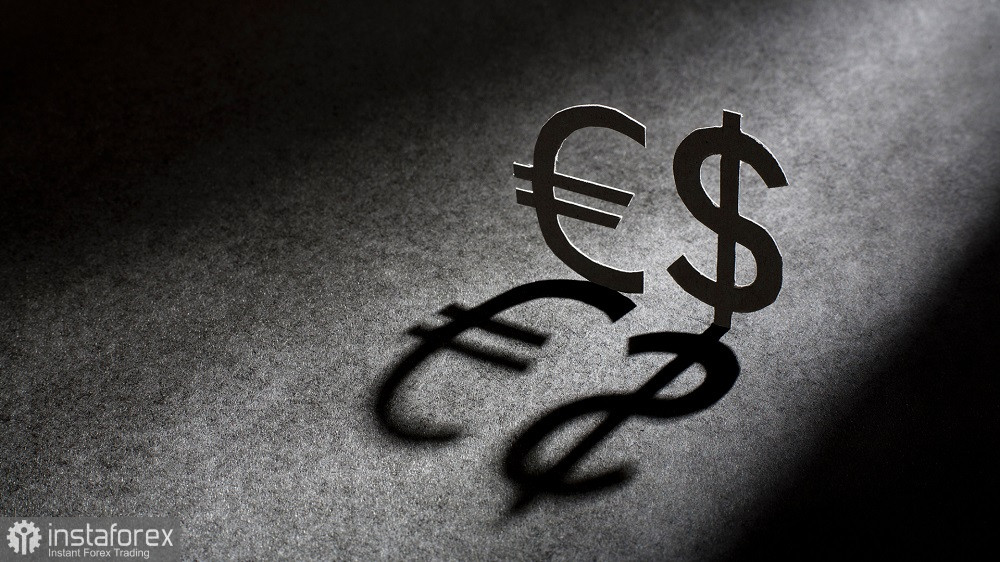Over the last six weeks, the EUR/USD pair has been facing a significant downtrend. If in mid-July traders were operating within the 12-figure range (even reaching the year's high at 1.1276), last week, the pair hit 1.0766.
This 500-point downward track (almost without any pullbacks) was primarily due to the dollar's growth. In a span of one and a half months, the Dollar Index rose from 99 points to its current value of 104.015. The euro acted as the follower, dutifully trailing the quoted currency. At the end of the past week, Federal Reserve Chair Jerome Powell provided support to the greenback, allowing the bears to enter the 7-figure area for the first time since June 2023. Powell signaled that the central bank is ready to continue raising interest rates if inflation ceases to slow down or starts to accelerate. He emphasized the importance of upcoming inflation indicators. If they reflect an increase in price pressures, the chances of another rate hike in one of the autumn meetings will significantly increase. Riding on hawkish expectations, the dollar might dominate across the market, including against the euro.

Regarding the euro's prospects, there remains a certain intrigue. Last week, the eurozone countries released disappointing PMIs. For the most part, these PMIs were in the "red" and below the key 50-point mark. In addition, the German indices from the IFO institute fell short of forecasts. After these reports, the market became skeptical that the European Central Bank would decide on another rate hike in the upcoming meeting. However, there's a caveat: before the ECB's September meeting, the inflation report for August. If the report aids the euro, the intrigue surrounding the possible outcomes of the ECB's September meeting will remain.
In other words, all eyes are on inflation. In this context, a few reports scheduled for the upcoming week stand out. First, there's the aforementioned report on eurozone CPI (on August 31st), followed by the report on the core PCE index (also on August 31st), and lastly, the Non-Farm Payrolls (on September 1st).
According to preliminary forecasts, the euro area Consumer Price Index for August will fall to 5.1% (the lowest value since February 2022). The core index, excluding volatile energy and food prices, is also expected to show a downtrend, dropping to 5.3%. For context, over the past two months, the core CPI stood at 5.5%, defying forecasts of a decline. If inflation indicators are at least at the level of forecasts (let alone in the "red"), the euro will come under pressure, and traders may revise the current 40% chance of an ECB rate hike in September downward from their previous estimate.
On the same day, August 31st, the US will release the core PCE index. As is well known, this is a crucial inflation indicator closely monitored by Fed officials. In May and June, the core Personal Consumption Expenditure index displayed a downtrend, ending up at 4.1% YoY (the lowest annual increase since September 2021). However, according to the majority of experts, it will increase in July, rising to 4.2%. Or even higher: speaking at the economic symposium in Jackson Hole, Powell forecasted a sharper growth of the core PCE – to 4.3%. He also mentioned the rise of the CPI and the Producer Price Index. If the actual result surpasses even Powell's forecast (i.e., if the index exceeds 4.3%), we may witness another dollar rally. In such a scenario, the greenback would gain a vital fundamental edge, considering Powell's hawkish stance at Jackson Hole.
Finally, on Friday, September 1st, key labor market data will be released in the US. The unemployment rate in August is expected to remain at the July level, which is 3.5%. However, the increase in non-farm employment may disappoint dollar bulls, with a forecast of 169,000 (the lowest value since April 2022). Nonetheless, traders will focus on the inflation gauge. The average hourly wage in August is expected to increase by 4.4%. This indicator has been at this level for four consecutive months, making August the fifth.
Naturally, the upcoming week is not limited to the three aforementioned reports. Some secondary reports will precede the main ones. For instance, on Wednesday, August 30th, Germany will release its inflation report. German inflation often correlates with pan-European inflation.
On the same day (i.e., Wednesday), a labor market report from ADP will also be released. This report serves as a kind of "precursor" to the Non-Farm Payrolls.
Certain volatility in the EUR/USD pair will also be triggered by other reports. For example, on Tuesday, August 29th, the US will release the consumer confidence indicator. On Wednesday, August 30th, in addition to the aforementioned data, we can look forward to another report on US GDP (second estimate). On Thursday, August 30th, we'll learn the value of Chinese PMIs for both the manufacturing and non-manufacturing sectors. Moreover, on Thursday, the minutes of the last ECB meeting will be published. On Friday, September 1st, in addition to the Non-Farms, the ISM manufacturing index will be released, which could also affect the greenback, especially if it significantly deviates from the forecasted value.
In other words, we're in for a rather "hot", eventful week. By the end of it, the EUR/USD pair will either continue its downward track (dropping to the area of the 6th figure) or undergo a correction, heading towards the boundaries of the 9th figure.
 English
English 
 Русский
Русский Bahasa Indonesia
Bahasa Indonesia Bahasa Malay
Bahasa Malay ไทย
ไทย Español
Español Deutsch
Deutsch Български
Български Français
Français Tiếng Việt
Tiếng Việt 中文
中文 বাংলা
বাংলা हिन्दी
हिन्दी Čeština
Čeština Українська
Українська Română
Română

